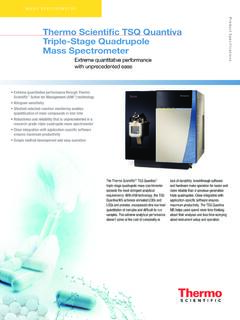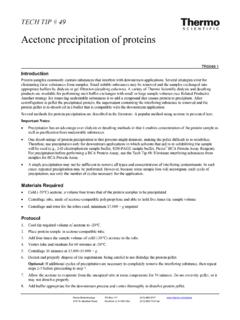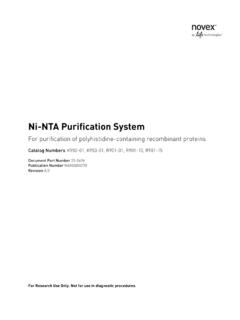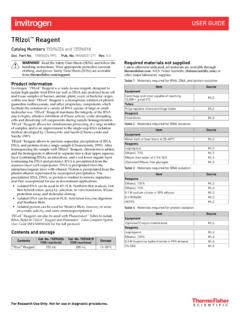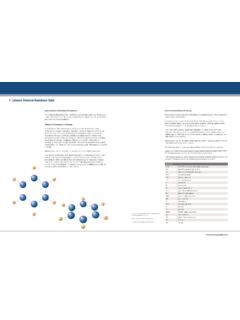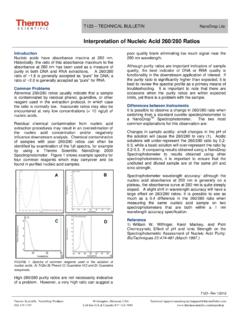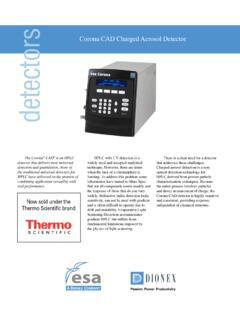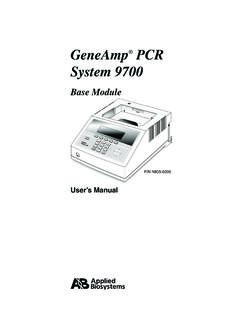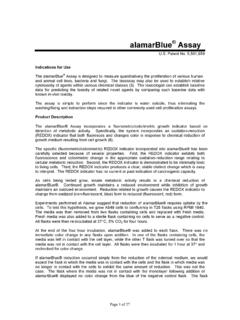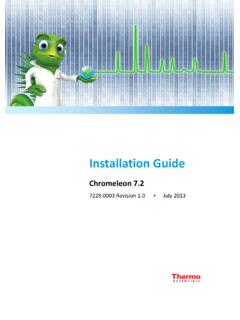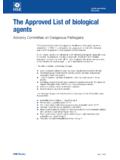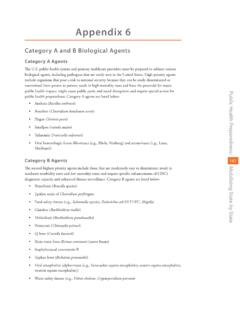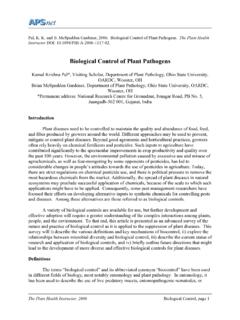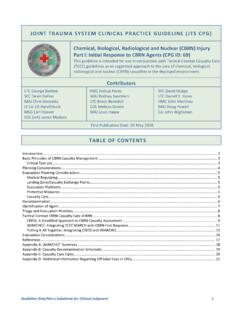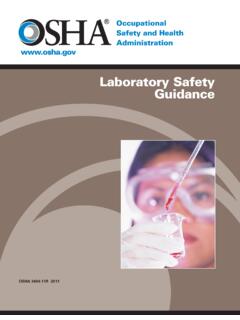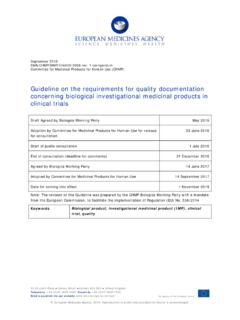Transcription of Biological Safety CABIBNET Application Note
1 Understanding the differences between Class II, Type A2 and Type B2 Biological Safety CabinetsNorth America, and EN12469: 2000 Biotechnology Performance criteria for microbiological Safety cabinets2, which originated in currently recognizes four types of Class II BSCs. Another class is planned to be added in 2017. Classes include: A1 A2 B1 B2 C1 (not recognized until 2017)Author: Marc Dunn, Technical Applications Specialist BSC and Clean Air, Thermo Fisher Scientific Key words: Biological Safety Cabinet, BSC, Class II, A2, B2, NSF, EN12469 IntroductionA Class II Biological Safety cabinet (BSC) is a ventilated containment device found in laboratories around the world. BSCs are used in many applications, including cell culture, pharmaceutical, clinical and microbiological work.
2 Due to the critical nature accomplished inside these commonly used laboratory products, BSCs are regulated through rigorous standards and compliance. Engineered controls are built into the design of BSCs providing protection to the operator, product and , different regions have their own standards applicable to BSCs, and manufacturers build and test to the criteria set out in these two most common standards used globally are the NSF/ANSI 491, which originated in Application NOTE The EN12469 standard recognizes one type of Class II BSC, which is generally equivalent to the Class II, Type A2 BSC as specified by NSF (Figure 1).European Class II and NSF Class II, Type A2 BSC accounts for approximately 95% of the global install base of any class or type of BSC3.
3 It is the most commonly used BSC, primarily due to the versatility and high levels of protection 1. Image of a Class II, Type A2 BSC that accounts for approximately 95% of the global install base of any class or type of BSC (Thermo Scientific 1300 Series BSC pictured).The Class II, Type B2 BSC (commonly known as a B2) is widely used and accepted in North America. B2 BSCs can also be found in the Middle East but rarely in China and other Asian Pacific countries. Toxicology is the main Application for a B2. However, within Europe, it is extremely rare to see a Class II, Type B2 BSC used in a laboratory. Applications, such as toxicology work, would see a different approach regarding BSCs, mainly using a thimble Type A2 in place of a B2.
4 European manufacturers produce what is known as a Cytotoxic Class II BSC, which is built to DIN129804 (Cytotoxic Standard) as well as conforming to the European Cytotoxic BSC is still an A2 type there is confusion and misconception within the industry as to when to specify or use an A2 or B2 BSC. What type offers better Biological containment? What applications can they be used for? Can a Type A2 BSC be used for work with chemicals? These are just some of the questions regularly posed by laboratory professionals when considering a BSC purchase. This Application note will explain the differences between types of BSCs and the strengths and weaknesses of these types to educate and clarify some of the confusion surrounding A2 and B2 II BSC similaritiesAll Class II BSCs provide four types of protection.
5 First, they protect the BSC operator from airborne Biological hazards from the BSC work area with an inward flow of air at the front opening. Second, they protect the laboratory and external environment from hazards inside the BSC work area by filtering the air exhausted or drawn from the BSC. Third, they protect the samples in the BSC from airborne contamination in the laboratory with a downward flow of filtered air inside the cabinet onto the BSC work area. Finally, they help prevent cross contamination within the BSC work area through the use of a flowing and uniform downflow onto the BSC work we begin to look at the differences between the A2 and B2 types, we should first note that the airflow within the BSC work area is the same for all types of Class II BSCs.
6 There is the inflow being drawn in the front opening but immediately captured into the front intake grille. This provides personal protection. There is the filtered flow of air inside the cabinet, flowing down from the top of the BSC work area to the work surface, where it splits with half of the air going to the back grille and the other half going to the front intake grille. Smooth and clean downflow provides the product and cross-contamination protection. Where the four or five types of Class II BSCs differ is in the source of the downflow air and where the air drawn from the BSC work area goes. Class II, Type B2 BSC How it worksFor a B2 BSC, the air is pulled in at the front aperture creating an air barrier that gives the operator protection.
7 Air is also pulled from an opening at the top of the cabinet that supplies the downflow fans with air (Figure 2). Then the air goes through a HEPA filter and is 100% exhausted through a dedicated duct with an exhaust fan motor. The air is then released into the atmosphere. The purpose of this is to remove toxic vapors that 2 All inflow air is100% exhaustedInflow airfeeding downflowInflow air providingair barrier andoperator protectionAmbient AirPotentially Contaminated AirClean AirFigure 2. Demonstration on how a Thermo Scientific Class II, Type B2 BSC generated in the cabinet with no recirculation within the BSC. Airflow through a B2 is 100% externally exhausted which means the air that is drawn into the cabinet is 100% exhausted into the atmosphere.
8 None of the air drawn into the B2 for either inflow or downflow is recycled within the airflow system. This is where an A2 differs as it does recycle a portion of its air after filtration approximately 60% to 70%.Class II, Type A2 BSC How it worksIn a Class II, Type A2 BSC air is drawn in through the front aperture, which provides operator protection (Figure 3). The inflow air mixes with the downflow air as it enters the front intake grille and then passes through the plenum where the air splits. Approximately 60% to 70% of the air is recycled and pushed back into the BSC work area through the downflow HEPA filter, and the remaining 30% to 40% is exhausted through the exhaust HEPA filter. This filtered exhaust air can be externally extracted with a thimble system, direct duct or simply extracted back into the laboratory.
9 However, if volatile chemicals are used within the BSC as an adjunct to microbiological work, exhaust must be released into the atmosphere through a thimble system or direct , in Europe, if small amounts of chemicals are used in a recirculating BSC and if approved by Safety personnel, a carbon filter may 3 Approximately 30% exhaustedApproximately 70%recycled via downflowInflow air providingair barrier andoperator protectionAmbient AirPotentially Contaminated AirClean AirFigure 3. Demonstration on how a Thermo Scientific Class II, Type A2 BSC between Class II, Type B2 and Class II, Type A2 BSCC haracteristicClass II, Type B2 BSCC lass II, Type A2 BSCA irflow patternNo recirculation within work area. 100% total flow is 70% of air is recycled and approx 30% exhaustedExhaust system typeMust be direct ducted as per NSFCan have three types of exhaust:1.
10 Recirculating filtered exhaust into room2. Thimble-type duct 3. Direct duct (only EN12469, NSF 49 does not allow direct duct for A2 type BSC)Inflow velocity 100 FPM (NSF 49) 100 FPM (NSF 49) m/s (EN12469)Downflow velocityNot definedNot defined (NSF 49) m/s (EN12469)Recognized by EN12469 NoEN12469 only recognizes 1 type of Class II BSC, which is very similar in design to an NSF 49 A2 type BSCbe installed after or as a part of the exhaust HEPA filter. IMPORTANT NOTE: NSF/ANSI 49 allows for an A2 BSC to be connected to a thimble (canopy) system but does not allow for them to be connected to a direct duct system. EN12469 allows both thimble and direct duct A2 A2 and B2 BSCsThere is a misconception that a B2 BSC is safer than an A2.
